In a country more commonly associated with sake than Chardonnay, it’s perhaps safe to assume that most expatriates believe the local wine industry is still a little wet behind the ears. However there are a growing number of respectable wineries in Japan that are well worth visiting, particularly those located in the Yamanashi region just an hour and a half from the center of Tokyo.
Wine producers found in Katsunuma, Yamanashi, account for nearly 40 percent of total domestic wine production. Although wineries located in this region have a long way to go before they are able to rival vineyards based in California’s renowned Napa Valley, each has its own unique history and offers interested parties the perfect chance to savor the very best that Japan has to offer – particularly if one falls into the ABC (anything but Chardonnay) category.
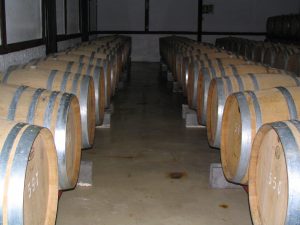 BOTTLE WITH A HISTORY
BOTTLE WITH A HISTORY
Legend has it that the very first grapevine arrived in Japan as long ago as 718 AD. Buddha Nyorai is believed to have presented a vine to a holy man named Gyoki, who planted it in what is present-day Yamanashi. However there is no record of wine being produced back then and the grapes that flourished on the vine each year were most likely added to the fruit basket or used for medicinal purposes.
Indeed commercial winemaking activities were not recorded in Japan until 1875, with growers since struggling to establish foreign grape varieties that were robust enough to handle the high humidity. Complicating matters further, the country’s first wineries were not permitted to own extensive vineyards and growers were required to spread operations over a large number of smallholdings. In fact, the average size of a vineyard until recently was just 0.25 hectares. Yet today grapes are grown in 46 of the nation’s 47 prefectures.
One grape variety that is particular to Japan is called Koshu, which arrived in the land of the rising sun via the Silk Road more than 1,200 years ago. Although it is traditionally an eating variety, local producers have adopted the grape to make wine. Typically Koshu produces a very pale, light, delicate wine that is generally sweetish, but goes surprisingly well with a broad range of Japanese food.
This variety has become a rallying point for many local winemakers trying to shake off the mantle of inferior quality that has stuck following Japan’s strategy of importing bulk wine, must (unfermented grape juice), grape concentrate and even grapes at the beginning of the 1980s. The strategy might have once been necessary in order to compete with rapidly growing market demand and competition from abroad. Some have argued it even helped the market in Japan grow. Ultimately, however, the strategy has done nothing but tarnish the reputation of local wine producers who have since tried to break into overseas markets.
Such is the significance of the variety that local officials have decided to name a city after it. Amalgamated in 2005, Koshu city incorporates the former principalities of Katsunuma, Enzan and Yamato, and anyone planning a wine tour around Yamanashi would be well advised to make this your first port of call.
In fact one of the highlights on offer this month is a wine tasting seminar organized by one of the country’s oldest and most respected wineries in honor of the new-look municipality. Chateau Mercian will host the seminar on October 8 and 9, breaking up the more formal proceedings with a Koso (a Chinese instrument) performance during lunch. The winery is also organizing a month-long festival in which visitors can enjoy guided tours and even crush grapes with their bare feet (see sidebar for more details).
DOING THE ROUNDS
Chateau Mercian (www.chateaumercian.com/cm/english/index.html) is a good starting point for anyone looking to learn more about Japanese wine. It boasts an old wooden winery that has been immaculately preserved as a museum, giving visitors an insight into how wine was made in the past. The Mercian Wine Shiryokan, which is located at 1425-1 Shimoiwasaki in Katsunuma town, also houses memorabilia, including bottles of the oldest Japanese wine. It is open daily from 9am to 4pm from June through December. From January through May, the museum is only open on Sundays and public holidays from 9am to 4pm and on other days by appointment. Call 0553-44-1011 for further information.
A short walk from here on the other side of the road one can tour Mercian’s Katsunuma Winery. It offers visitors a look at the future of the wine industry in Japan as it appears willing to pursue quality, adapt international grape varieties and utilize modern viticulture and vinivication techniques.
Visitors are also given “inside information” on particular varieties during a tour around the winery. My guide was quick to recommend Mercian’s Nagano Merlot (¥2,500), saying that it comes from the same vat as the winery’s famous Kikyogahara Merlot (¥8,000), albeit after the producers have made their selection.
Established in 1923, Chuo Budoshu is another excellent winery operating in the Katsunuma region. At least from a traditional perspective, Chuo Budoshu produces some of the best examples of Koshu available on the market and I would recommend The Basic “Grace Koshu” surlie (¥1,680) as a starting point. Surlie is a technical term. It refers to wine that is aged on sediment left after the yeast dies, which in turn imparts a slightly yeasty flavor. The technique is used in the finer Muscadets from the Loire region. Visitors can also try a range of vineyard-designated wines in the winery’s elegant tasting room and café, which boasts windows overlooking the property.
Wine critic Robert Parker, who is regarded as a barometer for the wine industry and whose comments can double the price of a wine, recently rated the winery’s 2004 Koshu Cuvee Denis Dubourdieu 87~88 points out of 100. It’s a dry, light bodied wine, made in a crisp delicate style with suggestions of green apples and grapefruit. The 2004 bottle has long been sold out, so keep an eye out for this year’s produce or perhaps even find a bottle in this overlooked wine region.
Also of note is the 2000 Cuvee Misawa. The 1999 vintage was awarded a trophy for best Japanese Wine at the 2000 Wine Challenge in Tokyo. It comes from the famous Toriibira vineyard area that is renowned for quality. Located on the side of a hill, the vineyard is so named because you can make out the outline of a huge torii (shrine gate) from a distance.
Established in 1924, Haramo Vineyard (www.haramo.com) is a small, family-owned winery that makes some of the best local wine. Unfortunately many of its bottles are not readily available outside the region, which makes a trip to Yamanashi all the more worthwhile.
Haramo’s courtyard is typical of many in the region, covered in a canopy of leaves and grapes. Local vineyards are traditionally trellised with an overhead system known as Tanazukuri, one of the endearing and somewhat unique features of Japanese production. According to a guide at the winery, the Tanazukuri system was originally designed with pickers in mind. One might note that the trellises at most vineyards appear to be a little on the low side. This is not because the Japanese of today are now taller on average but because they were built at a height that was convenient for the farmer’s wife who used to pick the grapes when ready.
While approximately 60 percent of Koshu goes into wine, the remainder is sold as eating grapes. Eating grapes are harvested from the end of August to the middle of November. Incredibly each bunch is individually wrapped in what is called a kasa (umbrella). As with many wineries, Haramo has a side business selling eating grapes. The winery charges ¥1,000 for visitors to eat as much grapes as they like, which is bound to be a highlight for any children you have in tow.
The winery also boasts a highly regarded restaurant, which is noted for organic food and delicious homemade bread. Diners can choose a mixed plate of food that offers a sample of everything, while barbecuing under the vines is another option with a reservation.
Nearby Katsunuma Winery is an example of a modern-style Japanese winery that has been cultivating its own grapes since 1991 and has the advantage of hindsight. It is quite accessible to visitors and offers a number of different tours. Kase restaurant, which prides itself on its roast beef, makes for a pleasant place to enjoy some food at the end of a long day.
Even if you make an early start, it is difficult to cover many wineries in a single day. If time is short, perhaps you’d be better off visiting Budo-no-Oka, which is located a short taxi ride from Katsunuma Station on the JR Chuo line. Established by a group of local wineries, Budo-no-Oka is the ultimate one-stop Japanese wine experience, especially for those without a car and driver. It has an underground cellar that boasts 170 labels. For ¥1,100, visitors are given a tastevin (a shallow stainless steel tasting cup), which you can keep, and a free rein to taste as many of the wines as you like.
The cellar is divided into two aisles with a row of barrels down the middle of each. Opened bottles adorn the barrels ready for tasting with spittoons strategically placed along the way. These same wines are available for purchase on shelves adjacent to the barrel. And of course baskets are conveniently placed beside the door. What more does one require? Also recommended is a visit to the Budo-no-Oka Museum, renowned for its collection of rare lacquered paintings. Coupled with reasonably priced accommodation and a restaurant with a noted view, there’s perhaps no better way to get a handle on Japanese wines and avoid years of trial and error.
After a recent visit to the area, my conclusion is that the region is generally better suited to whites and, more specifically, Koshu. A current vintage is preferable and, given the delicateness of the variety, provenance is vital. Bearing this in mind, your local discount store would not be the place to find a decent bottle unless it has proper storage facilities.
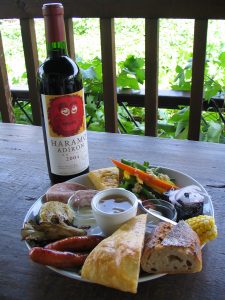
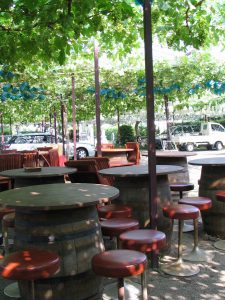
Story by J.K. Whelehan
From J SELECT Magazine, October 2005

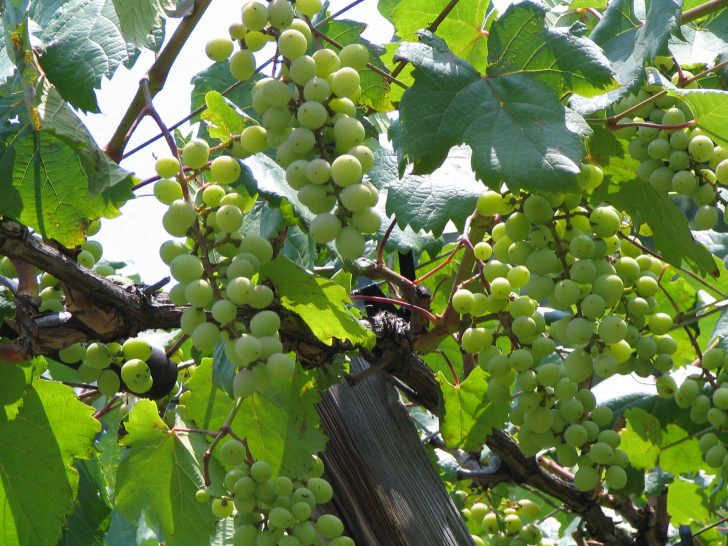

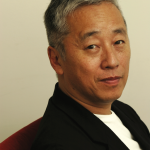

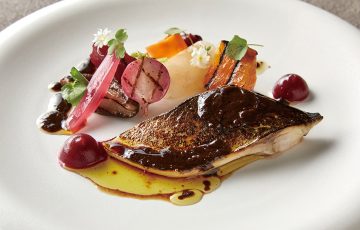



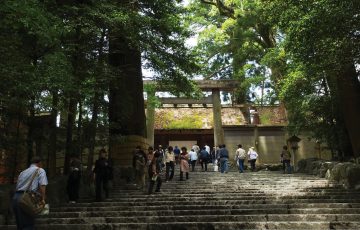
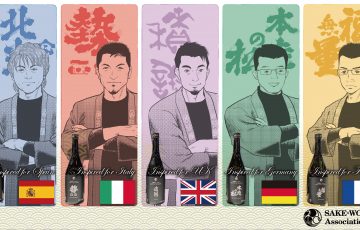
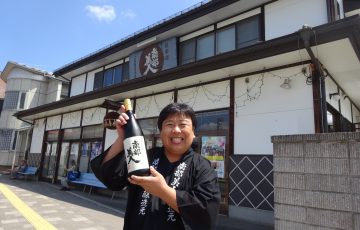
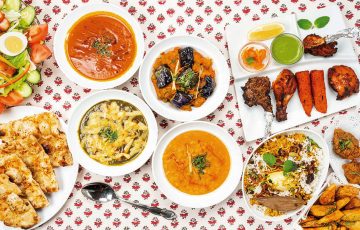


Recent Comments